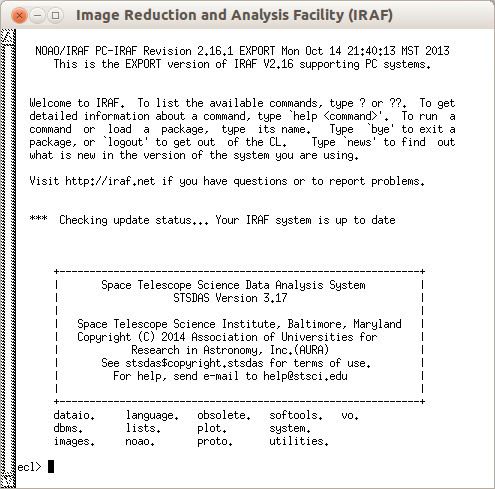Developer(s) NOAO Operating system | Stable release 2.16 / 22 March 2012 Type Astronomical Analysis | |
 | ||
IRAF (image reduction and analysis facility) is a collection of software written at the National Optical Astronomy Observatory (NOAO) geared towards the reduction of astronomical images in pixel array form. This is primarily data taken from imaging array detectors such as CCDs. It is available for all major operating systems for mainframes and desktop computers. Although written for UNIX-like operating systems, use on Microsoft Windows is made possible by Cygwin. It is primarily used on Linux distributions, with a growing share of Mac OS X users. IRAF is installed by default in Distro Astro, a Linux distribution for astronomers.
Contents
IRAF commands (known as tasks) are organized into package structures. Additional packages may be added to IRAF. Packages may contain other packages. There are many packages available by NOAO and external developers often focusing on a particular branch of research or facility. Of particular note are the STSDAS and TABLES packages by the STScI.
Just a few examples of functionality available in IRAF would be calibration of the fluxes and positions of astronomical objects within an image, compensation for sensitivity variations between detector pixels, combination of multiple images or measurement of the redshifts of absorption or emission lines in a spectrum.
Licensing
The licensing status of IRAF is conflicted but generally follows the MIT license scheme, with some older parts of the code under a different license. Most notably, several functions in the graphics infrastructure are under a non-free software license which does not permit redistribution without permission. As this code is tightly integrated into several of IRAF's tasks, the package as a whole was seen by several projects as non-redistributable and therefore non-free, and so efforts to package the software for drop-in installation in GNU/Linux systems have lapsed.
In March 2012, NOAO released v2.16 of IRAF, citing one of the "new capabilities" as "Removal of all license restrictions - IRAF is now free", and in 2013, there were efforts to create RPM Package Manager and deb packages of IRAF.
User-defined tasks
IRAF allows users to write their own tasks in two main ways. One is by writing non-compiled procedure scripts. The second is through compiled subset pre-processor (SPP) programs. Tutorial documents exist for both methods.
Technical details
A full IRAF working environment usually requires two other applications: an extended xterm window with a graphics windows (called xgterm and distributed in a separate X11-IRAF package by NOAO) and an image display program referred to as an "image server". The two most popular image servers are ds9 (by SAO) and ximtool (NOAO).
The ximtool image server supports 24-bit colors and is available for testing.
